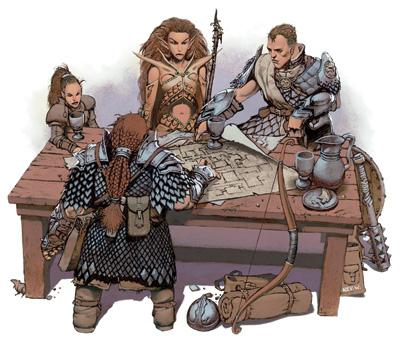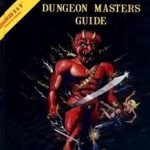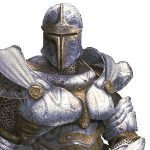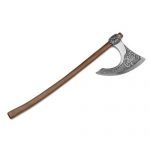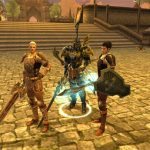The class system in D&D often comes under fire. Some arguments are that a certain class is too strong. For example, there are people that say this of the warlock, the favored soul, the warmage, or of material in the Tome of Battle, Tome of Magic, or the Expanded Psionics handbook. By the same rank there are people who argue that the fighter, sorcerer, Samurai, or Hexblade are far too weak to be effective at the roles that the class was designed for.
The first problem in a discussion of balance is deciding what we consider balance to be. If we mean a class is balanced compared to another class, then comparison is impossible. Each class is very different and has a different set of strengths and weaknesses; equality is not the way to go if looking for a meaningful comparison. To me, balance is when each class has a certain niche that they are able to fill allowing it to contribute fully to a group without special interventions. I define special interventions as specific DM fiats or houserules made to enhance a character or giving one character disproportionately more treasure or bonuses than anyone else. Examples of this might be if you add in penalties to make a particular class useless, if you decide to specifically weaken other classes by constantly challenging their weaknesses while leaving one class alone to allow it to shine, or tailoring all encounters to make a certain class or character be useful above all the others. If a DM makes a class called the pinmaster and makes a campaign setting called balloon world where only the pinmaster can reliably kill balloon beasts then yes, the pinmaster might seem a viable or even overpowered class, but that is only true for balloon world. This standard seems like a good way to evaluate balance–consider what niche a class fills, how well it fills it, and how effective it is overall.
Some classes get very difficult to evaluate because of how they are designed. One example of this might be the hexblade, a class that many initially regarded as a sort of gish. In truth, it’s a variation on the fighter that uses magic and dirty tricks to weaken foes and win in combat. You don’t try to tank with it and you have to be very careful with chosen spells to ensure a good combination. The duskblade is closer to a gish but it is more of a “deal lots and lots of damage” class rather than a true mixture of magic and melee.
I’m not sure that the warlock was meant to be any one thing. A blaster is the most obvious role but I’ve seen them used as debuffers, scouts and troubleshooters. Casters are similar; most people initially see them as mobile artillery pieces. I did myself when I started play, but after a while I learned the abilities allowed for battlefield control, total restructuring of a being, and thousands of tactical options. More options appeared as more spells were created and metamagic feats offered.
We can also evaluate classes by their effectiveness over the long haul of the game. Effectiveness may change greatly depending on the campaign style but that style is usually at least somewhat known at the start. If the game is going to be diplomacy heavy intrigue type then the smasher types might have a few issues but they know that going in. The problem I see is that each class has a curve of usefulness. A rogue, for example, will probably find use for themselves throughout the game. The traps will scale with them, and with Use magic Device as a class skill they can pull out a few other options to aid them in their role. A caster has a sharp growth in usefulness, as higher level spells are able to do more and more things both in and out of combat. Martial characters, however, usually decrease in usefulness after a certain point because the beings faced have such high hitpoint totals or because reaching the enemy to strike them is a task in and of itself. Combat maneuvers have similar issues: tripping stops working at around level 10, disarming fails against beings with natural weapons (quite common at high levels), sundering is usually a bad idea, and tanking only works if you can control all fields of movement.
Finally we can evaluate the versatility or specialization of a class. A barbarian is a fairly strong melee class, It is focused heavily on being a damage dealer, the muscle boosting power of rage being a nice springboard helping offset the penalties to hit from power attack (a feat common to barbarians). A Ranger is also focused either on archery or two weapon fighting and the spells that they have available amplify their abilities already gained from the granted feats and skills. A paladin has abilities which make them a better tank, lay on hands, the ability to remove diseases, and spells that they gain which can greatly increase their AC, saves, and other bonuses. The paladin also gets the benefits of a mount and can do great things with mounted combat as well. The rogue has abilities which can make them great scouts or assassins depending on the inclination of the person designing the character.
The Wizard, Cleric, Sorcerer, and Druid have an advantage in that their class abilities are highly mutable. Each day a caster can choose a new set of spells, making themselves artillery pieces, spies, troubleshooters, debuffers, buffers, healers, melee combatants, battlefield controllers, or some combination thereof depending on what spells they choose. This is a great power because it is an example of constantly expanding class abilities. Each new spell provides new tricks and stratagems for someone to use or to find a way to use in concert with other spells.
Of these, the fighter is the only one I see with a problem. While feats are useful, class abilities simply count for more, feat chains rarely merge well and many times will not augment previous feats on the chain. For example, Power attack, at least in core, has no feats which improve it. You have feats that show you know how to hit harder: Improved Sunder, Improved Bull Rush, Cleave, Great Cleave. Outside of core there are tactical feats and feats like leap attack which augment power attack but those feats are exceptions rather than the rule.
How do you improve a class’s ability to handle multiple challenges? A wizard would likely defer to a rogue to navigate a trapped area, just as the rogue would defer to the wizard in areas of knowledge and secrets, and both would likely defer to the bard in social situations. This is mostly on regular classes, but as I look I think that WotC has realized that some mistakes were made in class design in this regard and came up with an easy way to fix the problem, Prestige Classes.
Prestige classes can be many things: world builders, organizational forces, sources for plot hooks, and also a way to fix bad designs. There are a lot of people who argue that prestige classes are inherently bad for many reasons, and there are ways to abuse them. But, my own view is that prestige classes are a “patch” for the game. They’re a way to fix problems that crop up without having to rewrite the entire rules system. The Eldritch Knight is a great class for those that want to blend arcane power with combat and to try to create a harmonious blend of physical prowess and arcane might. I also argue that this class is a way to use the archetypical Spellsword without having to create new classes or come up with incredibly convoluted feat chains. It also means that you can blend the two rather classes that otherwise simply won’t mesh as well, like a level 10 wizard/level 10 fighter. The prestige classes can provide a way to make normally suboptimal hybrid choices work.
But my main focus is their use in fixing problems with classes. Many have argued that the fighter class has issues in it, one of the counter-arguments is that they qualify for many potent prestige classes; I call that a stealth fix. I believe that designers at WotC might have realized the problem with fighters, but what were they to do? They couldn’t rebuild the whole fighter class, and to produce enough feats to make it a truly potent class would be very resource consuming. Not to mention that these feats could easily break other classes if used. Instead they designed prestige classes based around fighter archetypes or offering new abilities for a style and have a fair amount of feats as a prerequisite. It means that the fighter, while not completely ‘fixed’ is patched enough that the character can still be useful at high levels. It also means that if a new class didn’t work as well as intended, or had some unforeseen problems, prestige classes could fix them by having requirements native to a certain class. It also lets WotC keep some things from getting out of control, if the casters are going nuts, Witch slayers and Occult slayers can help against them, almost every new system introduced that could have some issues also has counters built in as prestige classes where the material is introduced or can be countered by pre-existing prestige classes.
Prestige classes are a better option than rewriting each class because then all that happens is constant rewrites to fix things as they go and the game wouldn’t be stable. Instead, new material can offer new options through feats and prestige classes, and multiclassing options allow for a character to make something that will fit their concept as well as work well mechanically. It also means that the money keeps coming into the company and they can use book sales and feedback as a way to figure out what is working well versus what isn’t and react accordingly.

